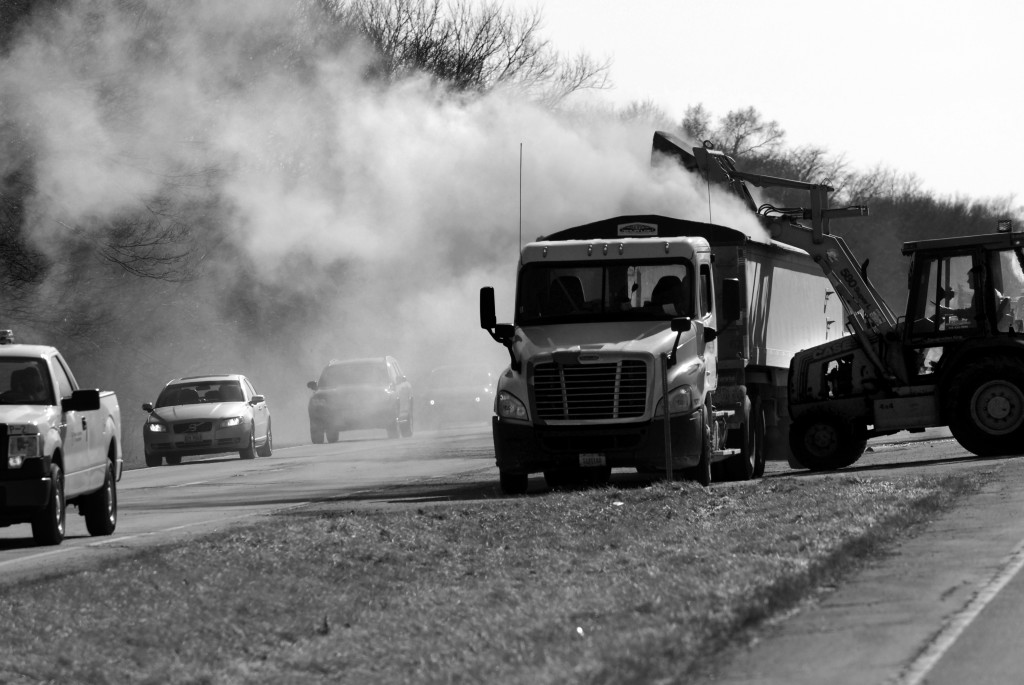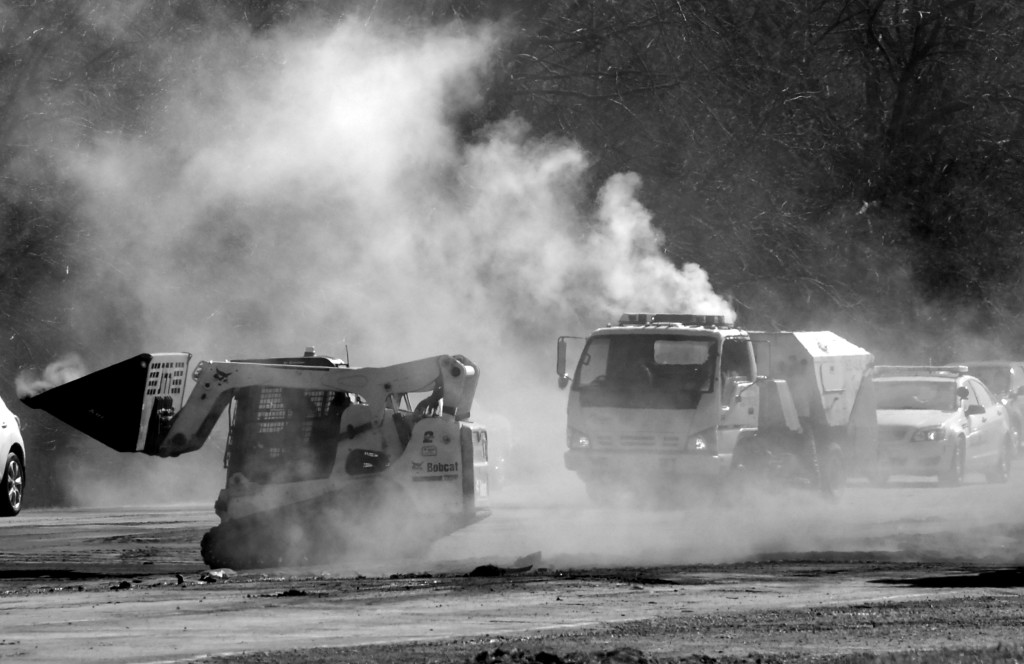The Illinois EPA was not notified about a crash on Route 29 north of Peoria that resulted in coal fly ash spilling over the highway. Two southbound lanes of the road were closed for hours during a cleanup operation involving front-end loaders and skid-steer loaders.

Toxic coal ash dust billows over northbound vehicles and nearby homes during cleanup following a crash on Illinois Route 29 that closed the southbound lanes for hours. A semi-trailer truck transporting coal fly ash crashed with a garbage truck on March 27. Photo by Clare Howard
“It was like trying to clean up dry water,” said one person at the cleanup operation.
Although the U.S. Environmental Protection Agency recently declined to label coal fly ash a hazardous substance, coal fly ash contains multiple toxins. EPA regulations call for controls to prevent people from breathing coal ash dust. Despite that warning, cleanup crews working on the Route 29 crash did not wear protective gear and coal fly ash swirled in the air around them, engulfed cars traveling north and drifted over nearby homes.
Scott Shepler and his wife, graphic artists living in Chillicothe, were going home from Peoria following the accident and drove through billowing clouds of coal ash that drifted over the northbound lanes of traffic.
“We coughed for hours after that,” Shepler said.
While the risk from a one-time exposure may not be significant, the lack of a public warning is a significant problem, an environmental scientist said.
“It’s unusual and troubling that precautions were not taken,” said Brian Urbaszewski, Respiratory Health Association, Chicago.
He noted that while one-time exposure may not create problems for most people, it could trigger asthma attacks. The fine particulate matter of coal fly ash is a lung irritant that affects the deepest portions of the lungs and is linked to heart attacks, strokes and premature deaths. Coal plants are the largest source of these pollutants in the state.
“It’s a symptom of a much larger problem in dealing with coal,” Urbaszewski said.
Workers wear protective gear when exposed to coal ash at the plant, he said, suggesting the same precautions should have been taken at the cleanup site.

Coal ash dust blankets the cleanup site like a dense fog following a crash on Illinois Route 29. Although the EPA has decided coal ash should not be classified as a hazardous waste, it does contain toxins and cleanup regulations call for protection from exposure. Photo by Clare Howard
Exposure of children in the homes near the accident site posed a greater concern, Urbaszewski said, explaining that children breath in 50 percent more air per pound of body weight and the impact of pollution is greater on a child.
Joyce Blumenshine, spokeswoman for the Heart of Illinois Sierra Club, said response to the crash highlights “flaws in the system. It shows the whole system is not set up to respond properly, and it’s always the public that’s at risk. This is not just one exposure. It’s one more exposure on top of multiple environmental exposures.”
Illinois EPA learned of the crash following an inquiry from Community Word. An agency inspector was sent to the site, but it was days after the cleanup and rains had disbursed most remaining residue.
EPA would not comment while it continues to investigate the accident.
Many environmental groups cite carcinogens, neurotoxins and radioactivity levels in the coal burning waste product that raise alarms.
Ed Stermer, who teaches at Illinois Central College, said coal fly ash has accumulated for decades and remains an unresolved issue, much like the question of dealing with spent nuclear waste.
“Just store it while we figure out what to do with it,” said Stermer, who teaches a class on energy and the environment. “Fossil fuels versus renewable fuels is like a deal with heaven or hell. Deal with the devil, and it’s great at first, and then we face payback. Renewables from heaven . . . but it’s hard to be a saint.”
Stermer said levels of radiation and toxins normally present in coal end up in concentrated levels in the coal fly ash.
Coal ash is a mixture of both heavy and fine materials that result after burning coal, he said, noting that fly ash is removed from smoke stacks by scrubbers that prevent toxins from becoming airborne.
“Disposal of fly ash has not been adequately addressed,” Stermer said, noting that the very fine particles readily enter the lungs and blood.
“A Geiger counter on fly ash will register radioactivity, but soil also registers radioactivity. Is it at levels any more dangerous than normal background levels? I don’t know. We rely on industry to tell us that. Yes, there are toxins in coal ash and it should be handled properly, but is the exposure significant enough to cause a problem?”
The coal industry promotes recycling use of coal ash to make concrete, gypsum board, roofing tiles, shingles and soil enrichments for agriculture. Coal combustion products including ash can be used as a base for roads, according to the American Coal Ash Association, a trade association.
A spokesman for Dynegy Energy based in Houston said the accident did not involve coal ash waste from the corporation’s Hennepin operation. He said Dynegy does not transport coal ash in open semi trucks like the one in the crash.
Although the Peoria County Sheriff’s department sent out a Tweet about the accident, officers there did not file a report and referred inquiries to the Illinois State Police. Despite multiple requests, no report was released by the Illinois State Police.
In response to a legal request for the crash report filed under the Freedom of Information Act, the state police cited the burdensome nature of the request and took an extension for complying. A spokesperson for State’s Attorney Lisa Madigan’s office said they could not intervenes unless the police failed to comply past the extension date. By deadline, the Illinois State Police had still failed to provide the crash report. Without the report, it’s not clear where the coal ash dust originated and where it was being transported.
Lisa Offutt, one of the founders of Peoria Families Against Toxic Waste, said, “We don’t take coal ash dust seriously enough. The bottom line is that safety doesn’t drive public policy. Costs for big corporations drive policy decisions.”
